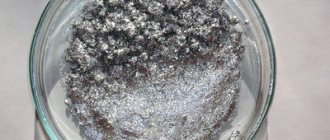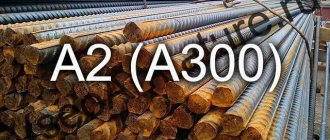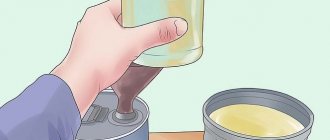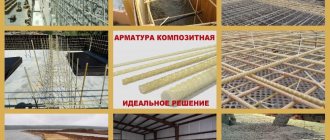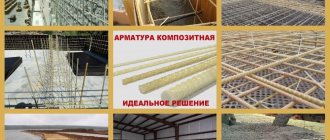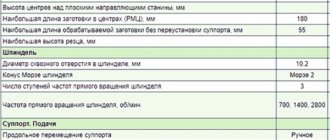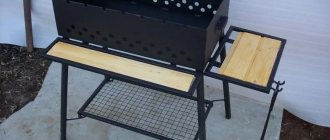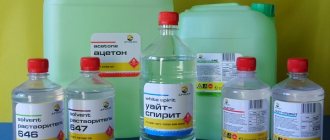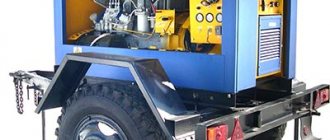The problem of increasing the corrosion resistance of painted surfaces has not lost its relevance to this day. The first and most necessary operation in the surface preparation process before painting is degreasing.
If you do not degrease the surface, you will not be able to achieve good adhesion, and the paint will begin to peel off very quickly in those places where there were stains and dirt. In most cases, surface degreasing is performed using organic solvents. But what solvent should I choose for this and how is this work done correctly? Let's take a closer look at this question: does solvent 646 degrease and is it always possible to use it?
Degreasing metal surfaces.
Solvent 646 is a multicomponent composition that includes several simple substances. It is considered one of the most popular solvents on the market today. It is very often used in car repair shops, since the physical and chemical properties of this composition are excellent for diluting car paints and degreasing car bodies. However, you should remember that this substance can very easily dissolve varnish and paint, so you need to use it very carefully and only before applying putty.
Before degreasing with a solvent, all visible contaminants must be removed from the surface. We should not forget that when working with solvents, you must use personal protective equipment, such as a respirator, goggles and gloves. Otherwise, poisoning with an organic solvent is quite possible.
- We clean the surface with a grinding machine or regular sandpaper. At this stage, you need to clean the surface of dry large debris, rust and dust.
- We wet a cloth with solvent and thoroughly wipe the entire surface to be treated. It is best to use solvent 646 as it provides maximum cleaning and excellent adhesion.
- After cleaning with solvent, leave the surface for a few minutes to allow it to dry completely. Now you can start priming and painting.
If someone has not yet understood whether it is possible to degrease with solvent 646, then the answer is obvious - it is possible, but very carefully. Don't forget that it can easily dissolve putty, varnish or paint.
Dmitrievsky Chemical Plant is a leading manufacturer of solvents in Russia. The production of multicomponent solvents, butyl acetate and acetic acid, has been carried out for more than 100 years. Therefore, you can have no doubt about the quality of this manufacturer’s products. Solvent 646 from the Dmitrievsky Chemical Plant is a product of reference quality, which has no analogues.
Any surface must be degreased before painting or carrying out other repair work. Degreasing refers to the process of removing any contaminants - dust, glue, grease, emulsions, old paint residues, and ordinary dirt. Methods and means for degreasing a surface are varied, most of them are easy to use at home.
Vershina universal degreaser
The Vershina universal degreaser has confidently begun to gain popularity among drivers.
It degreases well any surfaces made of metal, ceramics, glass and plastic. Easily removes various contaminants from the surface before painting or applying any anti-corrosion coatings. Recommended by the manufacturer for treating surfaces before gluing them. It is very convenient to use with a spray nozzle on the bottle. When dry, it leaves no traces.
Compliance with safety precautions when working with degreaser guarantees complete safety.
This is interesting! Alkyd enamel: what is it and how is it different from alkyd paint
The need to degrease the surface
Contamination of surfaces varies greatly in degree - with a weak amount of impurities is 1 g / square meter, with a strong one - more than 5 g. Whatever the degree, degreasing is required before carrying out repair work. If this is not done, grease and dirt will reduce the adhesion of the finishing material to the surface, therefore, the quality of the work will be low.
You should not count on how long the product will last - it will be short. For this reason, the use of degreasers for processing glass, wood, metal, plastic, and other coatings is mandatory.
Specifications 646
| Relative density | 0.87 g/cm3 |
| Boiling temperature | 59°С |
| Flash point | 6°С |
| Auto-ignition temperature | 428°C |
| Mass fraction of water (according to Fischer), no more | 2% |
| Ethyl ether volatility | 8-15 |
| Acid number, no more | 0.06 mg KOH/g |
| Coagulation number, not less | 35% |
Degreasing agents
If a person decides to paint a surface in a house, apartment, or country house, any suitable product is used for degreasing, which is applied to a lint-free microfiber cloth or other suitable material.
This method is not suitable if preparation for painting the car body is required. Of course, it is better to entrust the cleaning and painting of a car to a professional who will do the job efficiently. In some cases, you can remove the grease film and protect the car body from corrosion with your own hands.
White Spirit
Almost every car enthusiast has the organic solvent White Spirit, and repair shops use it regularly. White spirit is intended for the initial treatment of the body, after which it is practiced to apply alcohol mixed with orthophosphoric acid to remove residual contamination. The solution is prepared by combining substances in a certain proportion.
Using white spirit you can safely clean car parts; the composition will not harm the metal surface. Low cost is another plus. The downside is the strong smell. Some car owners replace the solvent with trichlorethylene, but it should not be used on aluminum alloys - there is a risk of fire.
Gasoline, acetone, other analogues
All of these products are good solvents for grease, mastic, and paint. Diesel and kerosene have a rather dense structure and are difficult to clean, but their composition is suitable for degreasing.
After using kerosene, gasoline, or solvent, you will have to use an enhanced wash to remove all traces. It is undesirable to use acetone for treating cars - some types of it can cause harm to the metal.
Antisilicone
Antisilicone is a colorless liquid, a remover for removing silicone, grease, and oil. This substance is intended to remove contaminants from steel, aluminum, stainless steel, plastic, galvanization, and varnish coatings.
How to degrease plastic
Plastics are one of the largest groups of materials, containing a variety of types of plastic. Gasoline, acetone, and vinegar are perfect for a number of plastics; other materials will immediately become unusable from such substances. Universal compounds are also not always suitable for plastic.
For plastic car parts, only special products are used, which are sold in relevant stores and are suitable for plastic and rubber. At home, you can try applying white spirit to the material. An antistatic agent will be 100% safe; most products can be degreased well with vodka.
The procedure for degreasing plastic before gluing it is as follows:
- Wipe off the dust with a (dry) cloth, if necessary, wash to remove obvious dirt, and dry.
- Soak a rag with solvent.
- Gently scrub the surface.
- If in doubt, try scrubbing a small area of the product first.
Traditional degreasers
Often, when servicing a car, the most common degreasers are used.
For the initial treatment of small areas of contamination, you can successfully use gasoline, kerosene and even diesel fuel. Primary treatment consists of preparing the surface of the iron for degreasing. For example, the manufacturer recommends using BR-2 solvent, also known as Galosh gasoline, for washing metal products.
This recommendation can be successfully applied to kerosene and diesel fuel (“diesel fuel”). By the way, gasoline or kerosene can be used to thoroughly clean and degrease leather and fabric products. The only drawback is that the smell will take a long time to dissipate.
This is interesting! What is drying oil: types, composition, technical characteristics and application features
Degreasing metal
In addition to grease and dirt, metal often contains rust, paint, and sealant residues. For metal processing you should choose white spirit, acetone, gasoline.
The procedure is as follows:
- Remove rust, paint, sealing residues with a grinder, manually, grinder, sandpaper - in any convenient way (the bathtub in the house is treated with a sponge and soda). It is better to clean large areas with a power tool.
- Moisten a cloth with solvent and treat the product until completely clean. If the parts are small, you can simply immerse them in solvent.
- After complete drying, you can apply primers and paints. Those areas that cannot be painted should be covered with double-sided tape.
Storage
Before using solvent 647, be sure to familiarize yourself with the basic rules of operation and storage.
- The composition must be stored in tightly closed packaging. Direct rays of the sun should not fall on the packaging. The room must have a high level of fire safety. The solvent should be stored out of the reach of children and animals. The ideal location is a dark and dry room that maintains room temperature.
- When using, it is necessary to ventilate the room. If there are no windows and ventilation cannot cope with the volatility of the solvent, you need to install fans in the room.
- The product packaging must contain instructions for using the product.
- Solvent 647 is sold for both industrial and household use. Buyers can choose from packages ranging from 0.5 to 10 liters, as well as large steel barrels for bulk purchases.
Wood products
Wooden products must be cleaned of varnish and paint before painting. At the first stage, you need to clean the wood as thoroughly as possible with a wire brush, sandpaper, or a plane. The latter is used to remove the top layer if the paint is deeply ingrained - with high-quality work, you don’t even need to degrease the surface.
For wood, special products and universal solvents are used; they are applied with a roller. There is no point in using gasoline. After applying the composition, you can easily clean the surface and then proceed to painting.
Remedies before gluing
The choice of degreaser for the materials being bonded will depend on what materials are being used. This can be ordinary household chemicals, alkali, alcohol, or organic solvent. For rubber, isopropyl alcohol is suitable. The main thing is not to apply products to wet surfaces - upon contact with water, many substances give an unpredictable reaction or become ineffective.
There is nothing complicated in degreasing and subsequent gluing and painting of products. It is important to familiarize yourself with the necessary information, purchase a suitable solvent - then all work will be completed efficiently and without consequences.
After degreasing is completed, you need to drop a couple of drops of water onto the surface: if the liquid becomes flat and spreads, the cleaning is done perfectly.
The need to prepare metal products for painting is due to an increase in the adhesion characteristics of the substrate to the paint and varnish material and the resistance of the metal to corrosion processes. All this will have a positive effect on the service life of the painted products. However, most owners are much more concerned about the presence of rust, which must be removed during the metal preparation process, than about degreasing, which is why painting work is carried out without this important and mandatory operation.
Aqueous solutions
Water itself is not an ideal liquid for degreasing surfaces - just remember attempts to wash greasy dishes with cold water. This is due to its high surface tension and its inability to emulsify fats.
To make surface degreasing with aqueous solutions effective, the following methods are used:
- increase pH acidity level;
- heat the solution to 55-60 oC;
- add surfactants (surfactants).
Water based degreaser
Aqueous solutions are quite effective against light and medium levels of contamination. They are significantly less dangerous to use than organic solvents.
What is defatting
The essence of the procedure is to remove fatty substances from the surface of the substrate, which are often present in cooling emulsions, mineral oils, preservative lubricants, and polishing compounds. Degreasing of the metal surface before painting also has to be done to remove residues from washing and etching, traces of sweat and fingers. All these contaminants can extremely negatively affect the quality of surface wetting with paints and varnishes, as well as harm film formation and other properties of the coating.
Depending on the amount of fatty impurities present per square meter, several degrees of surface contamination can be distinguished:
- Weak - up to 1 g;
- Medium - from 1 to 5 g;
- Increased - more than 5 g.
When processing fats with chemical reagents, several sequential processes occur on the surface:
Depending on the ability of fats to be destroyed under the influence of solvents, several types of contaminants are distinguished:
- Non-destructible - for example, emulsions.
- Pollinated - polishing materials, lubricant residues.
Chemical methods
The main type is organic solvents, which allow you to quickly remove grease and oily areas from metal parts. They are most widely used in individual production, although sometimes they are used in serial production, but not often due to their high explosion and fire hazard. The desired effect, namely the dissolution of oil and fat deposits, is achieved at the moment of contact of organic solvents with them.
The quality of surface degreasing is directly affected by the degree of solvent contamination, since the more fats are contained on the surface, the worse the chemical’s ability to dissolve existing deposits becomes. Most often, aliphatic and chlorinated solvents are used to remove fat and oil areas. Despite their high efficiency in metal cleaning, they have a serious drawback - these compounds are not able to remove abrasive materials and other mineral contaminants from the surface.
Aqueous solutions
As is known, water has poor purification ability, which is associated with significant surface tension and incompatibility with fats. Therefore, when it wets greasy surfaces, stable emulsions are not formed. To increase the cleaning properties of an aqueous solution, manufacturers resort to various techniques - increasing the pH acidity level, increasing the temperature regime of use to the range of 50-65 degrees Celsius, and introducing surfactants into the composition.
Alkaline degreasers
These compounds have a lot of positive properties. These include high cleaning ability, fire safety, environmental friendliness, and a wide selection of application methods. When treated with aqueous solutions of saponified fats and oils, the latter are inevitably destroyed, and unsaponifiable contaminants are emulsified. The latter case can be described as the process of detachment of fatty layers from the surface with gradual transformation into a working liquid and removal along with the working solution. The main disadvantage of these compositions is the need for anti-corrosion treatment of the surface after cleaning.
Among the components present in cleaning solutions, surfactants - surfactants - deal best with fatty and oily areas. Once on the surface, they form foam on it, simultaneously reducing interfacial and surface tension, increasing wettability and destroying solid and liquid contaminants, transforming them into a more convenient form for removal. The surfactant content in grease cleaners , as a rule, fluctuates within 10%.
If the need arises, along with degreasing, to remove thin oxide or hydroxide films, acidic solutions containing 1-3% phosphoric acid are used.
After treating surfaces with cleaning compounds, they must be washed with water. The presence of salt residues is unacceptable, since they can destroy the properties of paint films, increasing moisture permeability and accelerating the development of under-film corrosion.
Emulsion compositions
In cases where there is a need to remove oil deposits, grease, and difficult-to-remove contaminants from the surface, emulsion degreasing is used. This method is combined and has the advantages of organic solvents and aqueous alkaline solutions. These compositions contain emulsions of solvents and surfactants diluted with water. Chlorinated or aliphatic hydrocarbons can be used as solvents.
Ultrasonic and electrochemical methods
To increase the cleaning ability of detergent compositions, special baths with an ultrasonic field are used. This method is most relevant for small-sized products with a highly complex surface, for which it is important to remove contaminants with the highest quality possible. For large parts, it is not practical to use this method due to economic considerations, since there is a need to increase the output power of the device.
When preparing metal products using the electrochemical degreasing method, specially equipped baths are also used, and the process itself is carried out due to the action of gas bubbles formed on the electrodes. This makes it possible to reduce the consumption of components of chemical compositions and improve the quality of surface treatment.
Substance consumption and how to use
To increase the viscosity of the paint and varnish material, you should gradually pour in the solvent, at this time the components are stirred, the amount is determined based on the thickness of the paint experimentally. The solvent has the ability to quickly dilute substances, so whether the desired density has occurred will be immediately visible. It is important to thoroughly mix the entire mass until smooth. Also, when applying you need to be careful, the product can lead to destruction of the base.
The consumption of the substance when used as a degreaser per square meter of surface will be equal to:
- For facade treatment - 0.147 liters;
- For wooden and metal bases located indoors – 120 ml;
- For concrete material – 0.138 l;
- For any base when the climate is characterized by high humidity - 0.169 l.
To increase the viscosity of the paint and varnish material, you should gradually pour in the solvent, while stirring the components.
How to degrease metal before painting
In domestic conditions, owners, as a rule, use proven “old-fashioned” products - gasoline, kerosene, acetone, alcohol.
But today more modern and technologically advanced formulations are available. Among them, Nefras (White Spirit), Solvent 646 are quite popular. They have a lot of advantages - affordable price, increased level of environmental friendliness, the ability to form films that are more resistant to paintwork, which helps prevent the development of corrosion processes.
Types of compositions
Solvents can have different compositions and are used for different types of surfaces. So we can distinguish several categories of compositions:
- For oil paints. The compositions are made gentle so that they can be used to dilute materials for coloring in order to improve their characteristics. Most often in this case, white spirit, turpentine or gasoline are chosen;
- Thinners suitable for thinning bituminous paints, as well as for glypthal-based paints and varnishes. These are xylene and solvent;
- Composition for perchlorovinyl coloring materials. Acetone is the standard choice for them;
- Thinners for adhesive and water-based paints;
- Weak compositions for household needs.
Solvents can have different compositions and are used for different types of surfaces.
Popular solvents
How to degrease a metal surface before painting is a pressing question for many owners. To degrease metal surfaces, today you can use not only affordable and time-tested compounds, but also modern solvents.
White spirit
Among degreasers, white spirit is most often used. It looks like a transparent, colorless liquid with a characteristic odor of fuel and lubricants.
It is sold in stores under the name “Nefras-S4” and is available in various modifications. The main reason for its popularity is due to its versatility.
This solvent can easily remove any oils and fats, as well as many organic compounds. It is often used to dilute oil paints, enamels and varnishes. White spirit also has one more positive property - after treating the surface, you do not need to wait for it to dry; you can immediately proceed to applying a primer or paint material. The solvent evaporates very quickly, and this is what gives it superiority over other cleaning compounds.
Solvent 646
This type of degreaser is widely used when preparing for painting. It is a yellowish liquid with a strong characteristic odor. It has a fairly wide range of applications.
With this composition you can not only dilute paints, but also degrease metal surfaces. It is especially effective when you need to remove old layers of paint. Can be used for washing painting equipment and tools.
Best suited for diluting the following types of enamels:
- nitrocellulose NC;
- glypthal GF;
- melaninoamide MPs;
- acrylic;
- epoxy.
When using the degreaser, it is necessary to observe the temperature recommended by the manufacturer from + 5 to + 30 degrees Celsius, while the air humidity should not be higher than 85%. Then, after treatment, the metal surface will acquire a shiny, glossy appearance without stains or streaks.
Please remember that Solvent 646 is a flammable and explosive product. You can work with it only while wearing respiratory, eye and skin protection. When carrying out work indoors, it is necessary to ensure the supply of fresh air through windows and doors or through working exhaust ventilation.
Acetone: classic
Another fairly common metal degreaser. In terms of its composition, it is a transparent liquid with a strong characteristic odor. Excellent for removing oil and grease stains, as well as tar.
Acetone can be used to dilute varnishes, enamels, paints and primers. Sometimes it is added to the composition of some solvents. The main component is alcohol, which is highly volatile.
To protect metal surfaces from corrosion processes, they must be specially treated before applying paint. Dyeing technology requires an operation such as degreasing. It can be performed using various solvents and degreasing compounds.
Among them there are both traditional and more modern and technological ones. The choice of the most suitable composition for degreasing should be made taking into account the nature and scale of the tasks at hand, as well as the purpose of the metal product.
At the same time, it is important not to forget about safety rules during degreasing work. Many formulations are unsafe due to the content of compounds harmful to health. Therefore, when carrying out work indoors, it is necessary to ensure constant access to fresh air. You also need to remember that there are no flammable sources nearby.
Only “relatives”
But the fact is that the same liquids can behave differently with different paintwork materials: for some resins they can be thinners, and for others they can be aggressive solvents. Therefore, the use of unregulated thinners may lead to incompatibility with the diluted material, with all the ensuing consequences.
Sometimes this property of a “non-native” thinner can very effectively reduce the viscosity of a material, but God forbid it will negatively affect the process of film formation... And if the “kinship” is violated, this is often exactly what happens.
The fact is that each thinner is developed strictly for a specific material, taking into account compatibility with the base and additives in its composition. When adding certain liquids to a formulation, the developer of paints and varnishes calculates the sequence and rate of chemical reactions, so both the drying process of the material and the quality of the final paintwork (hardness, gloss, etc.) depend on the correct choice of thinner.
That is why it is so important to use only liquids recommended by the manufacturer to dilute paints and varnishes. By replacing a branded product with some “left” one, we initially doom ourselves to failure.
Meanwhile, such a replacement is practiced quite often: painters choose high-quality expensive primers, paints and varnishes, but instead of the recommended thinner they pour the cheapest domestic liquids, and after problems arise they begin to blame the paint manufacturer for everything.
